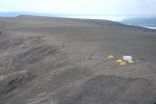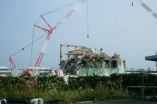(Press-News.org) The rotten egg gas leaking from sewer pipes and costing billions of dollars worldwide in odour control may soon be far less of a problem thanks to new research discussed at the 2012 International Water Association (IWA) conference this week.
Trials with a magic mix of chemicals, called Cloevis, on sewers in the Gold Coast region in Australia stopped 99 per cent of the rotten egg gas or hydrogen sulphide emitted from these pipes.
Lead researcher, Professor Zhiguo Yuan from the University of Queensland, told IWA delegates that one week after dosing for a few hours, in most cases the gas level increased to less than one fifth of its emissions prior to the treatment, and this has been repeatedly observed over a period of five months.
"We are currently looking to commercialise Cloevis and are doing a further four trials of the mix in the US and Canada," Professor Yuan says. "Our partners over there are very excited by Cloevis' potential".
The gases causing the bad smells in sewers also play a role in corroding sewer pipes, which is another costly problem especially in warm climates.
Professor Yuan's team, involving active participation from key members of Australia's water industry, is also working on corrosion issues and have another study into chemical free methods for managing hydrogen sulphide gas.
"We have done some trials with oxygenation of sewage using an electrochemical method which has reduced hydrogen sulphide enormously," he says. "We probably won't stop all bad smells from sewers forever but we're well on the way to reducing their extent."
Other speakers at the IWA conference spoke about managing bad smells from sewers and wastewater drains once they had escaped.
Dr Valentina Lazarova from France reported on trials on the strong smells coming from the Oued El Harrach River in Algiers. Her team used jasmine-smelling micro sprays on the highway crossing the river and gels on pedestrian bridges nearby to mask the smells.
"We used 1000 questionnaires and face-to-face interviews with local people and found out that 70 per cent of the population were satisfied or very satisfied with what we did and 96 per cent wanted the project to continue," she says.
Zdaravka Doquang from France talked about how to determine how bad a sewage-based smell is for people, with regards to both its type and intensity of smell. Her team has developed an 'odour wheel' for sewage smells that: "helps to classify odours and ensure a common language to communicate about the odours."
"People are most sensitive to hydrogen sulphide or rotten egg gas compounds both qualitatively and quantitatively compared to any other compounds," she says.
###
For interview:
Professor Zhiguo Yuan, University of Queensland, phone +61 402 385 909, zhiguo@awmc.uq.edu.au
Dr Valentina Lazarova, valentine.lazarova@suez-env.com
Zdaravka Doquang , zdaravka.doquang@suez.env.com
For media assistance:
Jenni Metcalfe, Econnect Communication, phone +61 408 551 866, jenni@econnect.com.au
Alison Binney, Econnect Communication, phone +61 428 900 450, Alison@econnect.com.au
Solving the stink from sewers
Latest research from the International Water Association Conference, Busan, Korea
2012-09-21
ELSE PRESS RELEASES FROM THIS DATE:
Researchers develop new 'stamping' process to pattern biomolecules at high resolution
2012-09-21
Fabricating precise biomolecular structures at extremely small scales is critical to the progress of nanotechnology and related fields.
Traditionally, one of the ways this has been accomplished has been through the use of rubber stamps with tiny features — similar to those used by children in play, but detailed at the microscopic scale — which are covered with molecular "inks" and then stamped onto substrate surfaces, creating a molecular patterns. But when using this technique at the nanoscale, molecules tend to diffuse on the surface both during and after stamping, ...
Advancing the treatment of trauma
2012-09-21
With traumatic injuries claiming almost six million lives a year, improvements in care, including in the challenging areas of brain and bone injuries, and haemorrhage, are urgently needed.
Leading medical journal The Lancet today published a series led by researchers and clinicians from the National Trauma Research Institute (NTRI), a collaboration between Monash University and Alfred Health, which notes the difficulties and charts the progress in improving three critical areas of trauma care.
Traumatic brain injury (TBI) is the leading cause of trauma-related deaths ...
'Kick-starting' male fertility
2012-09-21
Adding a missing protein to infertile human sperm can 'kick-start' its ability to fertilise an egg and dramatically increase the chances of a successful pregnancy, a team of Cardiff University scientists have uncovered.
The team from Cardiff University's School of Medicine first found that sperm transfers a vital protein, known as PLC-zeta (PLCz), to the egg upon fertilisation. This sperm protein initiates a process called 'egg activation' which sets off all the biological processes necessary for development of an embryo.
Now, the team has found that eggs that don't ...
Nunavut's mysterious ancient life could return by 2100
2012-09-21
This press release is available in French.Global climate change means that recently discovered ancient forests in Canada's extreme north could one day return, according to Alexandre Guertin-Pasquier of the University of Montreal's Department of Geography, who is presenting his findings at the Canadian Paleontology Conference in Toronto today. "According to the data model, climate conditions on Bylot Island will be able to support the kinds of trees we find in the fossilized forest that currently exist there, such as willow, pine and spruce. I've also found evidence of ...
Nudge or think: What works best for our society?
2012-09-21
If approached in the right way, citizens are willing to change their behaviour and do more to help themselves and others, according to research funded by the Economic and Social Research Council (ESRC). The project, carried out jointly at the universities of Manchester and Southampton, experimented with different interventions techniqueswhich encourage citizen participation and explored people's motivations for community involvement.
The researchers focused on comparing the effectiveness of 'nudge' techniques, where people are offered incentives to change their behaviour, ...
Research blog: An expedition to the Earth's fiery heart
2012-09-21
Volcanic activity on and around La Réunion is driven by a localized upwelling of hot buoyant magma. Unlike most magma sources, this is not located on the boundary between two tectonic plates, and rises from much greater depths. It is a so-called hotspot, and has left behind on the overlying mobile crust a track of volcanic activity that stretches 5500 km northwards to the Deccan Plateau in India. Some 65 million years ago, in a process that had a massive impact on world climate, the Deccan area was covered with enormous amounts of lava as the Indian Plate passed over the ...
New challenges for ex-Olympians
2012-09-21
When elite-level athletes retire, they often struggle to adapt to their new lives. When finding that the characteristics that were valuable in sport are not equally useful in 'ordinary' life, they often start experiencing disorientation, depression, self-doubt or even illness. This is concluded in research from the University of Gothenburg.
Successful athletes at the elite level develop characteristics that should generate success also later in life. However, this notion may be wrong, according to the new research.
As part of a study, ex-Olympians from Sweden, Switzerland, ...
23 nuclear power plants are in tsunami risk areas
2012-09-21
The tsunami in Japan in March 2011 unleashed a series of negligence related with the resulting nuclear disaster. A scientific study headed by Spanish researchers has for the first time identified those atomic power plants that are more prone to suffering the effects of a tsunami. In total, 23 plants are in dangerous areas, including Fukushima I, with 74 reactors located in the east and southeast of Asia.
Tsunamis are synonymous with the destruction of cities and homes and since the Japanese coast was devastated in March 2011 we now know that they cause nuclear disaster, ...
Remarkable enzyme points the way to reducing nitric acid use in industry
2012-09-21
An enzyme in the bacterium that causes potato scab could help create new, environmentally-benign biocatalysts with the potential to cut use of the highly corrosive chemical nitric acid.
Chemists at the University of Warwick in the UK, in collaboration with researchers at Cornell University in the USA, have reported in the journal Nature Chemical Biology the discovery of an enzyme in the bacterium Streptomyces scabies that catalyses an aromatic nitration reaction.
TxtE, a cytochrome P450 enzyme, is the first example of an enzyme that has specifically evolved to catalyse ...
Swedish journalists to the left of the public and elected politicians
2012-09-21
On the political scale, Swedish journalists can be placed to the left of the Swedish public and their elected politicians. And the distance between the two sides has increased significantly in recent decades, although this is more due to the public and politicians having moved to the right than to journalists having moved to the left. These are the results of a study conducted at the University of Gothenburg, Sweden.
'The transition of journalists farther and farther to the left on the political scale stagnated in the mid-1990s,' says Professor Kent Asp, who headed the ...
LAST 30 PRESS RELEASES:
Making lighter work of calculating fluid and heat flow
Normalizing blood sugar can halve heart attack risk
Lowering blood sugar cuts heart attack risk in people with prediabetes
Study links genetic variants to risk of blinding eye disease in premature infants
Non-opioid ‘pain sponge’ therapy halts cartilage degeneration and relieves chronic pain
AI can pick up cultural values by mimicking how kids learn
China’s ecological redlines offer fast track to 30 x 30 global conservation goal
Invisible indoor threats: emerging household contaminants and their growing risks to human health
Adding antibody treatment to chemo boosts outcomes for children with rare cancer
Germline pathogenic variants among women without a history of breast cancer
Tanning beds triple melanoma risk, potentially causing broad DNA damage
Unique bond identified as key to viral infection speed
Indoor tanning makes youthful skin much older on a genetic level
Mouse model sheds new light on the causes and potential solutions to human GI problems linked to muscular dystrophy
The Journal of Nuclear Medicine ahead-of-print tip sheet: December 12, 2025
Smarter tools for peering into the microscopic world
Applications open for funding to conduct research in the Kinsey Institute archives
Global measure underestimates the severity of food insecurity
Child survivors of critical illness are missing out on timely follow up care
Risk-based vs annual breast cancer screening / the WISDOM randomized clinical trial
University of Toronto launches Electric Vehicle Innovation Ontario to accelerate advanced EV technologies and build Canada’s innovation advantage
Early relapse predicts poor outcomes in aggressive blood cancer
American College of Lifestyle Medicine applauds two CMS models aligned with lifestyle medicine practice and reimbursement
Clinical trial finds cannabis use not a barrier to quitting nicotine vaping
Supplemental nutrition assistance program policies and food insecurity
Switching immune cells to “night mode” could limit damage after a heart attack, study suggests
URI-based Global RIghts Project report spotlights continued troubling trends in worldwide inhumane treatment
Neutrophils are less aggressive at night, explaining why nighttime heart attacks cause less damage than daytime events
Menopausal hormone therapy may not pose breast cancer risk for women with BRCA mutations
Mobile health tool may improve quality of life for adolescent and young adult breast cancer survivors
[Press-News.org] Solving the stink from sewersLatest research from the International Water Association Conference, Busan, Korea

